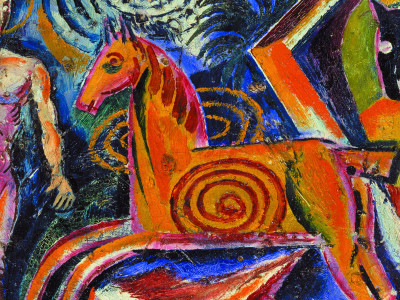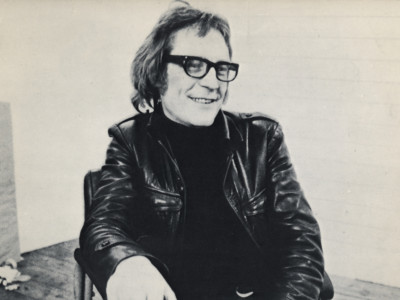
10 RA Schools stories through the centuries
By Mark Hampson
Published on 16 May 2024
Mark Hampson tells the stories of some of the former students of the RA Schools, from its inception in 1769 to the present day.
From the Summer 2024 issue of RA Magazine, issued quarterly to Friends of the RA.
The Great and the Good but not a Grand start
The RA Schools has awarded medals for student achievement since its foundation in 1769. Recipients have included several famous artists but also many other less familiar names forgotten by history. Mauritius Lowe became the first Gold Medal winner for Painting. His prize included a cash stipend (sponsored by Samuel Johnson) to enable him to undertake the Grand Tour of Italy in the hope of motivating a renaissance in English art. Controversially, he chose instead to stay in London in a state of indolence and dissipation, enjoying its seraglios and taverns. Other beneficiaries, such as sculptor Thomas Banks RA (1770) and architect John Soane RA (1777), salvaged the reputation of the prizes by travelling and returning to great acclaim.
A pack of wild beasts and their Keeper
The life drawing room was hallowed ground for the early students of the Royal Academy (former students Rowlandson and Pugin captured this special space when it was in Somerset House). But discipline in this sanctuary was not always consistent. Incidents of unruly, boisterous behaviour, including impromptu cricket matches, battles involving peashooters and amateur dramatics, were renowned.
On one occasion the Schools’ Porter was kidnapped and locked inside the life models’ changing room. On another, a loud commotion disturbed the Keeper, Henry Fuseli RA, who as head of the Schools was working in his studio nearby. Discovering pandemonium, he shouted, “You are a pack of wild beasts!” To which a quick witted student replied, “Yes sir, and you are our Keeper!”, swiftly diffusing the amused Fuseli’s anger.

“There was an old man with a beard….”
Much emphasis is placed on the precocious talents of the child prodigies who studied at the Schools. Turner and Landseer both enrolled at the age of 14, while the youngest, Millais, was only 11.
But not every student was so youthful. In 1850, when Edward Lear – the much-loved author of The Owl and the Pussycat – went, in his words, “with a large book and a piece of chalk to school each day like a good little boy”, he was ancient by comparison, aged 38. Feeling too old and experienced as an artist, he struggled to settle into student life and sadly only attended for a number of months (he represented his experience in one of his inimitable drawings).
Do you have eyes in your fingers?
The modern Schools Library is more welcoming than that supervised by ‘Old Cerberus’ – the famously gruff librarian Richard Wilson RA who terrified his Georgian students. “What are you about?” he once shouted at an individual who dared to study. “Drawing from this print,” the student nervously replied. “Drawing! Don’t paw the leaves, sirrah! You’ll spoil the book. What! Have you got eyes in your fingers, boy?”
Fortunately, such discouragements did not deter later graduates from creating their own literary gems, including the poems of Blake and Rossetti, Mervyn Peake’s Titus Groan trilogy, Heath Robinson’s illustrated compendiums and more recently Issy Wood’s blogs-turned-book Queen Baby.

A shout out to the trailblazers
When Laura Herford became the first female student in 1860, “Her invasion was artfully planned”, recalled her fellow painter George Dunlop Leslie RA. After anonymously submitting a portfolio of drawings signed only with her initials, her gender was revealed, to much surprise, only on her arrival. Her entry to the Academy marked a significant turning point for women artists in the UK.
Thirty years earlier, William Morrison Brown had become the first Black RA student – one of only two students of colour recorded in London at this time. The Jewish painter Simeon Solomon was admitted in 1856, an artist now championed as a courageous Queer icon, whose androgynous images of same-sex desire inspired both worthy praise and shameful sexual persecution.

The first charge of the Avant Garde
The Schools has strong ties to two of the most curious regiments of the British Army. The ranks of the Artists Rifles, founded in 1859 in response to the threat of a Napoleonic invasion, were mainly artists, poets and architects. Tasked with dangerous missions to draw enemy defences, they were commonly the first soldiers to be deployed – the Avant Garde. As a consequence they often suffered heavy fatalities, including 35 students of the Academy during the First World War.
By comparison, the United Arts Volunteer Rifles were London’s home guard. Nicknamed ‘The Unshrinkables’, they drew respect and ridicule as they drilled in Burlington House’s courtyard, dressed in makeshift uniforms with their white sweaters and carrying cricket bats, broomsticks and garden tools as improvised weapons.
The studios also served
During the world wars most of the female students remained at the RA in support. Some joined the Red Cross as nurses in the temporary hospital set up in the galleries and studios. A small group skilfully made blankets and scarves spun from dogs’ wool donated by local pet owners. Five of the Schools’ studios were loaned to the Admiralty for painterly experiments: camouflage designs for naval vessels. Due to the necessary secrecy attached to the creation of these ‘dazzle ships’, we know little about the personnel involved, except that most of the artists were young female students.

Rebels with a cause
The postwar period birthed a new invasion – Modern Art, inspiring a generation of students who rebelled against the Academy’s figurative traditions. They included Pop pioneer Richard Hamilton, modernist sculptor Anthony Caro and the abstract painters Sheila Girling, Paul Huxley and Basil Beattie. Sandra Blow attended the Schools but quickly departed, finding the teaching dull and old fashioned. When John Hoyland exhibited his radical student paintings, an outraged Academy President Charles Wheeler ordered them to be removed. Many of these young rebels would later become respected RAs.
Drawn to trouble
The most notorious RA student of the 20th century took full advantage of the traditional teaching of the Schools. Eric Hebborn honed his talents to become a brilliant forger, amassing an estimated $30 million fortune from sales of ‘copies’ of Old Masters. His forgeries fooled many of the world’s major museums, curators and collectors, and some are still suspected undiscovered in several international collections. His creative criminal activities also resulted in long prison sentences and unfortunately his brutal murder.

What a performance!
The contemporary art school has created an evolving enthusiasm for time-based media, new technologies and performance art. This has spilled out from the Schools parties, open studio events and the now legendary Stampede nights across the whole RA campus. Audiences have encountered a naked football match in the galleries and have been serenaded by an Elvis impersonator in the Cast Corridor. Endurance snogging, lavish community group dance-offs and a mock funeral procession have all delighted, challenged and surprised guests. There are also rumours that late one night a lone female performer flashed the Farnese Hercules, the RA’s cast of the huge ancient statue of the masculine hero. CCTV evidence is currently being examined.
Mark Hampson is an artist and Head of Fine Art Processes at the RA Schools.

Enjoyed this article? Join the club
As well as free entry to all of our exhibitions, Friends of the RA enjoy one of Britain’s most respected art magazines, delivered directly to your door. Why not join the club?
Related articles

Visions from Ukraine
19 June 2024

In memoriam: Mick Moon RA
1 May 2024

Making Space
15 March 2024